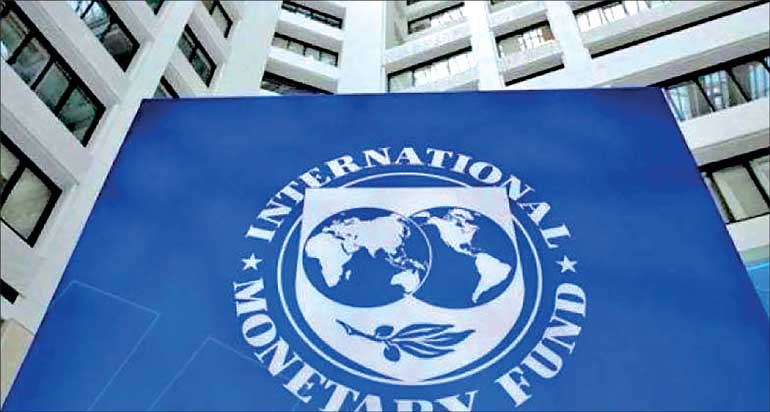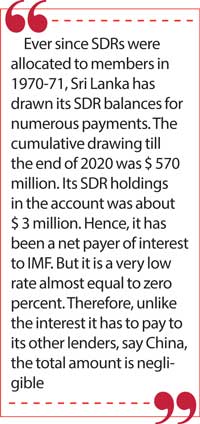Monday Apr 07, 2025
Monday Apr 07, 2025
Monday, 6 September 2021 00:05 - - {{hitsCtrl.values.hits}}

When you get SDRs from IMF, you receive an asset. At the same time, you assume a liability also to other members
Aseni, the wiz kid interested in learning anything economic, has been puzzled by the media reports that Sri Lanka had got some $ 780 million worth of Special Drawing Rights, known as SDRs, from the International Monetary Fund or IMF. Some had attributed this to Sri Lanka’s reaching back to IMF for a loan to resolve its acute balance of payments problems. If it were a loan, some had charged that the Government had increased its foreign debt levels mortgaging the future of Sri Lankans. Aseni, therefore, sought the wisdom of her grandfather, Sarath Mahatthaya, a former Finance Ministry official, to understand the issue. Following is the dialogue between the two:
 Aseni: Grandpa, what is this SDR allocation? The whole market is confused because the press notice issued by the Central Bank does not clarify it. Some say that it is a loan from IMF, and some say it is not. What is your view on that?
Aseni: Grandpa, what is this SDR allocation? The whole market is confused because the press notice issued by the Central Bank does not clarify it. Some say that it is a loan from IMF, and some say it is not. What is your view on that?
Sarath Mahatthaya: You can understand it if you know what these SDRs are. They are simply an artificial currency created in the books of IMF as far back as 1969 to help the countries in the world to undertake trade and commerce without being hampered by lack of means to pay for them.
As you know, when we do international trade, we expect to be paid in a currency which we can use for further trade or keep our global value in store for later use. These currencies are called reserve currencies. They need to have one qualification. That is, they should be freely convertible into an asset like gold, if the worst comes, backed by the strength of their internal economies. The US dollar satisfied this qualification after World War II and, hence, was the main reserve currency in the world.
Besides, USA had agreed to allow its dollar freely convertible to gold at a fixed rate of $ 35 per fine ounce of gold, which was known as the ‘Gold Exchange Standard’. Hence, the other countries did not have a problem of accepting dollars as a reserve currency. But USA had to produce dollars in adequate amounts in line with the growth in the international trade to allow smooth trade transactions.
If the world did not have enough dollars, it could not pay for trade just like if we do not have enough money, we cannot pay our bus fare. This is called the situ characterised by a global liquidity shortage. So, USA had to fill global liquidity shortage by producing dollars over and above its domestic needs. The trick for doing that was to run a trade deficit, that is, it should import more than it exports.
Aseni: Oh, I now understand why USA runs a chronic trade deficit year after year!
Sarath: But it serves itself as well as all of us in the rest of the world. It serves itself by producing a piece of paper called dollars at a cheaper cost and using that piece of paper to get what we produce with labour and other resources which we collectively call real resources, and enjoy a good life. For instance, when we produce a shirt, we spend our real resources, and our sacrifice is a real sacrifice. But USA enjoys that shirt just by giving us a piece of paper called a dollar.
However, it serves us also because by using that dollar, we can buy our medicines from India, India can buy laptops from Korea, and Korea can buy steel from China and so on. As long as that dollar is accepted by other countries in the chain, there is no harm in producing that dollar by USA.
Aseni: What it means is that if USA does not produce enough dollars, for example, we run into the problem called lack of global liquidity, don’t we?
Sarath: Exactly. The whole world therefore relied on USA to supply them with enough liquidity by running a trade deficit continuously.
Aseni: Then, why was it necessary for IMF to create its artificial currency called SDR?
Sarath: There was a fear that if USA failed to do its job one day, the whole world trade would collapse due to lack of global liquidity. As a risk mitigation measure, IMF thought that a supplementary liquidity source should be provided. That was why it created SDRs.
In fact, its fears were justified in 1971 when USA unilaterally withdrew from this Gold Exchange Standard due to its runout of gold reserves because the open market price of gold went above the fixed rate $ 35 per fine ounce providing profit opportunities for people to buy gold at $ 35 and sell above that price in the open market and coming back to US Treasury again and play the game. In economics, this is called arbitraging in which one would buy a commodity from a low-priced market and sell it at a high-priced market if the underlying transport and other costs are negligible.
 Aseni: Did SDR take over the job of being the global reserve currency from the US dollar?
Aseni: Did SDR take over the job of being the global reserve currency from the US dollar?
Sarath: No. There was a reason for it. SDR is created as an agreement with IMF members who are willing to participate in the SDR program. In practice, all members have joined the program. To operationalise it, IMF has set up a separate SDR Department within its organisation which functions with a separate accounting system from its other operations.
In the SDR Department, there is a separate account for each participating member. When SDRs are allocated, the account of the member country is credited by that amount. It is therefore a book entry done through IMF’s computer servers. In this sense, SDR is the first crypto currency created in the modern era, 40 years before Bitcoin was introduced in 2009.
The payment and settlement part is managed by the SDR Department. You can understand it by visualising the working of a current account department of a commercial bank. Thus, when a member wants to make a payment in SDR to another member, his account is debited, and the account of the payee member is credited. They are all book entries. It is not IMF which has the liability for SDRs created. It is all the participating members who take that liability collectively.
Hence, when you get SDRs from IMF, you receive an asset. At the same time, you assume a liability also to other members. SDRs could not replace the US dollar because of this complex payment mechanism, failure to create sufficient stock to meet the needs of the global transactions, and, above all, private individuals and entities could not use it because they cannot hold it. Therefore, for transactions, SDRs cannot be used speedily and efficiently like a physical currency which is backed by the strength of the economy of the issuing nation.
Hence, SDR continued to serve as an artificial currency that can be used only for transactions with IMF and other members who are willing to receive payments in SDRs. This latter category is a minority.
Aseni: That means we should convert SDR into another convertible currency before we start using it for general transactions, shouldn’t we?
Sarath: Yes, most probably into dollars. For that purpose, either USA or any other country should be willing to give us dollars accepting SDRs from us. In addition, there are 15 private entities which have been designated by IMF for dealing in SDRs.
Aseni: But why should either USA or any other country accept SDRs and give us dollars? What is their incentive to hold on to SDR balances?
Sarath: Countries may need SDRs to make payments to IMF. USA might do so simply to permit the world trade to take place smoothly. Besides, the holders of SDR will earn interest at the SDR interest rate fixed by IMF weekly.
Aseni: How is this interest rate determined? Is it determined in the market like say interest rate applicable to US Treasury securities?
Sarath: No, SDR interest rate is not determined in the market. Rather, it is determined by IMF by using a formula containing the short-term interest rates applicable to government securities in the five member countries whose currencies have been included in the basket of currencies which make up of SDRs. These five currencies are the US dollar, Euro, Chinese Renmimbi, Japanese Yen, and the Pound Sterling. USA and the European Union are the biggest economies in this block, and, therefore, they have a high weight amounting to 42% and 31% in the basket, respectively. This is followed by Chinese Renmimbi at 11%, Japanese Yen at 8%, and British Pound at 8%.
When fixing the SDR interest rate, there is a floor of 0.05% or 5 basis points below which it cannot fall. In 2019 when the market interest rates were high for government securities, SDR interest rate was also high at 1.1%. But today, the formula yields a rate of 0.0356%. But since it is below the floor rate, the applicable interest rate is 0.05%.
Aseni: Grandpa, how does the interest payments on SDRs work out?
Sarath: It is like a double-edged sword. If a member country holds SDR balances in its account, IMF pays interest to that member country at today’s rate of 0.05%. But if the member country uses those SDRs, it has to pay interest to IMF on the cumulative drawing of SDRs at the same rate of 0.05%. Since almost all the countries have used their SDR balances for various payment purposes, they have become net interest payers to IMF.
Aseni: Since Sri Lanka has used up its SDR allocations, it should be a net interest payer to IMF, I suppose.
Sarath: Yes, you are correct. Ever since SDRs were allocated to members in 1970-71, Sri Lanka has drawn its SDR balances for numerous payments. The cumulative drawing till the end of 2020 was $ 570 million. Its SDR holdings in the account was about $ 3 million. Hence, it has been a net payer of interest to IMF. But it is a very low rate almost equal to zero percent. Therefore, unlike the interest it has to pay to its other lenders, say China, the total amount is negligible.
Aseni: What about the current allocation of SDRs equal to $ 780 million? Should it pay interest to IMF on that allocation?
Sarath: No, as long as it is kept in SDR form in its account, IMF will pay interest to Sri Lanka at the current rate of 0.05%. But there is no purpose for Sri Lanka to keep it in SDR form without using it. Hence, sooner or later the country will utilise it for its purposes. At that time, Sri Lanka will have to pay interest to IMF.
Aseni: Some say that it is a gift to Sri Lanka and not a loan. Is it really a gift, Grandpa?
Sarath: It is not a loan since Sri Lanka does not have to repay it to IMF. It is a gift because every country without asking for it will get it from IMF. But it is not free because Sri Lanka has to pay interest on the cumulative drawing at the prevailing interest rate. At present, it is low at 0.05%, but it might go up in the future once the five basket currency countries start introducing tight monetary policies to fight inflationary pressures in their respective economies.
If it happens, Sri Lanka will have to pay interest forever, as long as IMF has its SDR Department, on the drawn-up balance. That balance may be about $ 1.5 billion after Sri Lanka has drawn the entirety of the current allocation. This is the risk. In the case of other loans, there is no commitment to pay interest once the loan has been fully paid. But here, it is an eternal payment obligation. It becomes a too much of a problem if the rate rises to a high level.
Aseni: Since the SDR allocation is not a loan, this will not increase Sri Lanka’s external debt indebtedness, will it be?
Sarath: It does not increase Sri Lanka Government’s external debt position. For that matter, even a loan from IMF does not increase the Government’s external debt level. But the accounting treatment is somewhat funny. IMF allows members to treat the SDR balance in its account with the SDR Department as a foreign reserve. But it has to treat the value as a liability arising from foreign reserves. Therefore, the Central Bank has to carry it in its books as a liability it owes to foreigners.
The implication is that when the Central Bank calculates its net foreign assets for assessing the money supply and the reserve money base, this allocation has no impact on either one of them since the liability part is reckoned as a foreign liability. But when the Bank calculates the net foreign reserves which includes the foreign reserves of the Government as well, this liability is not netted against the reserves. Hence, this allocation of SDRs will increase both gross reserves and net reserves equally.
Aseni: Given Sri Lanka’s current situation, this allocation is a blessing in disguise. Don’t you think so, Grandpa?
Sarath: Yes, but it has a downside risk as well. Our Government might be exhilarated by this seemingly free gift and postpone the introduction of the needed macroeconomic reforms or refrain from going to IMF for a bailout package. It would make the allocation purposeless. Hence, IMF has warned that the member countries concerned should not use this as a cover to avoid introducing the needed macroeconomic reforms. I hope the Sri Lanka Government will pay heed to this warning.
Aseni: Thank you Grandpa, it was a very useful dialogue.
(The writer, a former Deputy Governor of the Central Bank of Sri Lanka, can be reached at [email protected].)